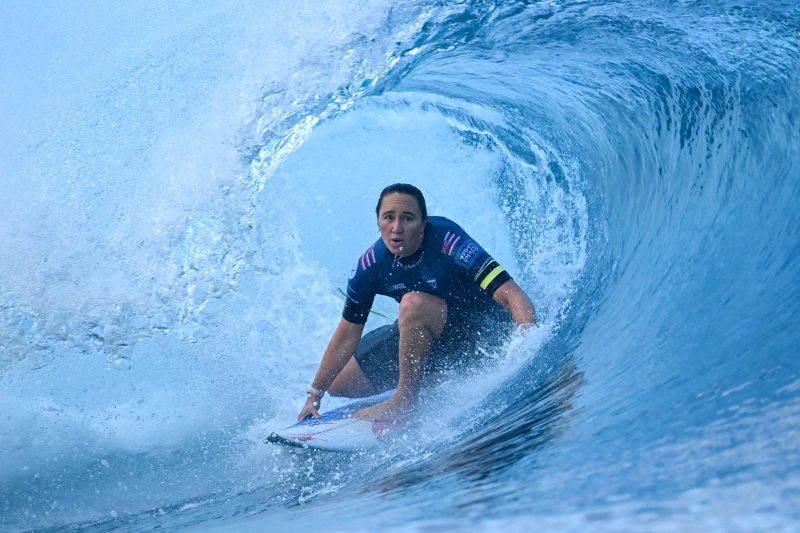The beauty and the beast, surfer Carissa Moore said of her sport, and the site for surfing during the Paris Olympics epitomizes the duality.
The wave of Teahupo’o, a small village on the French Polynesian island of Tahiti, will provide breathtaking sights, with surfers barrel riding through the powerful, hollowed-out wave.
The face of those waves measured eight to 10 feet high for a pro competition in May and at other times have exceeded 20 feet.
“The takeoff point is super steep and critical, so you have to have the skill and reaction time to time it right,’’ said Moore, who won gold at the Tokyo Games in 2021 during the Olympic debut of surfing. “And if you don’t, there can be consequences.
Get Olympics updates in your texts! Join USA TODAY Sports’ WhatsApp Channel
Meet Team USA: See which athletes made the U.S. Olympic team and where they are from
“People have had big falls and big injuries, so just knowing that that’s a possibility, you’re like, ‘Oof.’ It makes that fear factor even greater. But you could also get the thrill of your life, the best ride of your life.’’
Just several weeks before the start of the Olympics, footage from Teahupo’o showed a surfer being towed into the wave on a jet ski. What took place next was a specular ride on a wave well over 10 feet and evidence the waves actually could be too big.
Surfers will need to paddle into Teahupo’o wave, a site where last year two highly regarded surfers suffered injuries that led to hospitalization.
“I’m a little nervous about the venue,’’ Moore said, “but I’m going to try my best, give myself the best chance.’’
Why is Olympic surfing in Tahiti?
Paris, about 100 miles from the nearest beach on the Atlantic Ocean, for obvious reasons is not a hotbed for surfing.
With about $100 million, the Olympic organizing committee might have built a wave pool within view of the Eiffel tower.
Fat chance.
France does have a handful of top-notch surfing sites on the coastline of other parts of the country. But the chances for quality surf there are remote from July 27 to Aug. 5, the window for the Olympic surfing competition.
Enter Teahupo’o, which historically produces spectacular waves during this time of year. Yet issues remained.
For starters, logistics. Tahiti is almost 10,000 miles from Paris, which means the surfers will not be able to participate in the Opening Ceremonies on July 26. They will, however, be able to take part in the Closing Ceremonies.
Then, there are environmental concerns. The Olympic organizing committee faced opposition from residents of Teahupo’o and environmental groups that feared the surfing competition would damage the coral reef and potentially compromise the wave itself.
The Olympic committee made compromises in building a scaled-back judges’ tower. Now, with those hurdles clear, the wave of Teahupo’o can do its thing.
“It doesn’t get better than this,’’ said Fernando Aguerre, president of the International Surfing Association.
Understanding the Teahupo’o wave
You don’t have to be an oceanographer to understand why the wave of Teahupo’o is one of the best and most dangerous in the world.
“It’s very simple to understand it for a person that doesn’t understand the ocean,’’ said Aguerre, president of the ISA.
OK, class in session.
Tahiti, a volcanic island, is steep and high and drops sharply, Aguerre explained. Like most of the French Polynesian islands, he added, it is surrounded by a ring of shallow coral reef.
This shallow water is the wave breaks. Where it begins is in a zone more than 300 feet deep.
“So the wave comes with all this power from deep water, deep ocean,” Aguerre said.
The wave picks up speed as it moves from the relatively short distance between deep to shallow water. The dynamic produces not only one of the strongest waves in the world but also a fast ride, which typically lasts less than 10 seconds.
In practice, Moore said, she has worn an ‘impact suit” with foam to protect her back and legs if she were to fall onto the coral. Griffin Colapinto, a member of the U.S. Olympic surfing team, said he experimented with a helmet during practice in the spring.
“So far,’’ Colapinto said, “my experience has been that you can pretty much get the best wave of your whole life at the risk of dying.’’






